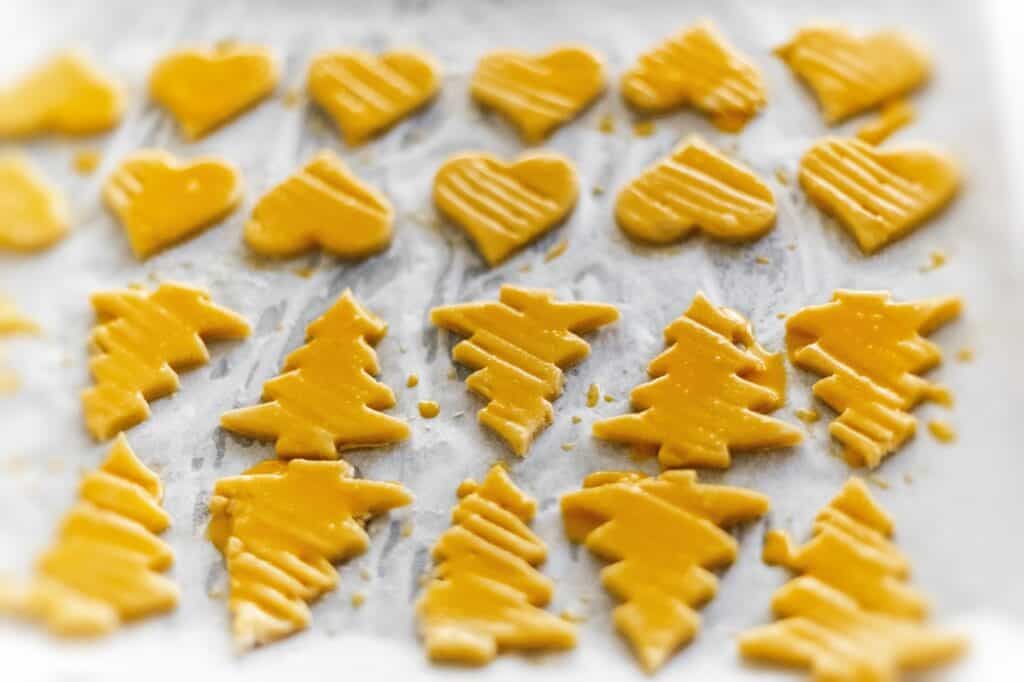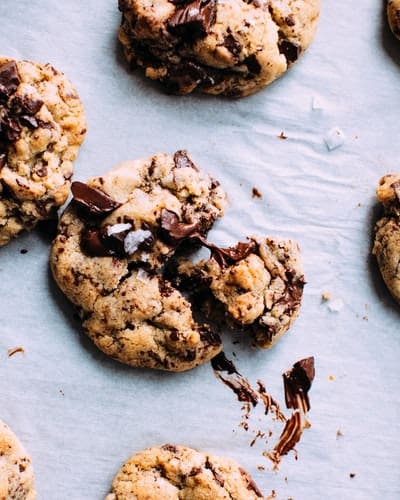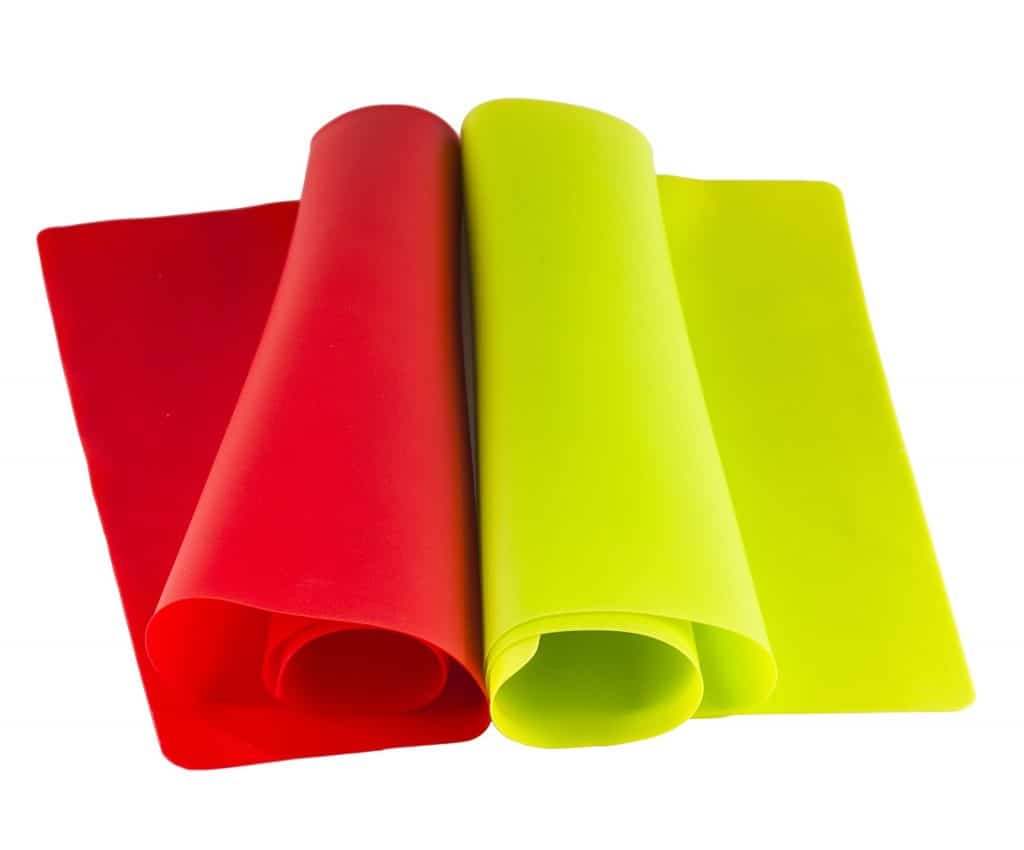As an Amazon Associate we earn from qualifying purchases.
Silicone bakeware has been a fantastic addition to the home cooks tool kit. From spatulas and spoons to molds, tins, and mats these heat resistant non-stick wonders are quickly replacing their metal, plastic, and wooden counterparts.
While buying silicone cookware is easy (just don’t go over 450°F / 230°C with them), cleaning silicone cookware can be quite a novel endeavor. The chief offender of the bunch is the silicone baking mat.
Quick Navigation
- How to Clean Silicone Baking Mats
- Methods to Remove Grease and Fat from Silicone Baking Mats
- Step 1: Place Mat on a Baking Sheet in Oven
- Step 2: Turn Off Oven When It Comes to Temperature
- Step 3: Dust Silicone Mat With Baking Soda
- Step 4: Close Oven and Let Sit for 15 Minutes Minimum
- Step 5: Wash With Hot Water
- Step 6: Air Dry the Silicone Baking Mats in a Rack
- Additional Tips for Cleaning
- Why do Silicone Mats Become Greasy?
- Why Should I Deep Clean My Silicone Mats?
- How Often Should I Clean My Silicone Baking Mats?
- Conclusion
How to Clean Silicone Baking Mats
Here’s a quick outline of how to clean silicone baking mats, which I will talk about in detail below:
- Place mat on a baking sheet in the oven
- Turn off oven
- Dust mat with baking soda
- Let sit for 15 minutes
- Wash with hot water
- Air dry

Methods to Remove Grease and Fat from Silicone Baking Mats
Grease, fat, and oil can be removed in 2 main ways:
- Using strong acids ~pH 2 or lower
- Using bases ~ph 9.5 and higher.
Acids will neutralize the fats and bases will saponify (turn them to soap). I’ll be going over the baking soda method in detail, but if you want to use lemon juice or white vinegar, just add that to the hot rinsing water rather than directly to the mat.
Step 1: Place Mat on a Baking Sheet in Oven
Turn your oven on to 300°F and place the silicone baking mats in the oven on a baking sheet as the oven is heating up. When silicone is heated, it becomes porous and allows some of the fat and oil from the food you are cooking to move into the mat. By heating the mats up I can do a few things.
First, I reopen those pores so I can get access to the oil stuck in the mat.
Second, any fats that are solid at room temperature will be liquified, allowing easier application of cleaning products.
Finally, baking soda is not a particularly strong or great base for saponification. I use it because it is safe and readily available. Heating the fat and baking soda together to around 150°F / 65°C will help the saponification process complete more efficiently.
Step 2: Turn Off Oven When It Comes to Temperature
As stated in step 1, I want an average temperature around 150°F / 65°C for my process to work. It’s also going to take 15 minutes or so for the reaction to occur.
Turn your oven off when it hits 300°F. The fat will be rendered out, the mats pores open, and the residual heat will average out long enough for my baking soda to do its work. If you have a super accurate low temperature oven you can just set it for 150-200°F and just hold it there for 15 minutes.
Most ovens are pretty poor at keeping temperatures below 250°F though. While I have not tried this, it is conceivable you could sous vide your silicone baking mats or do the boiling water in an ice chest trick as well.

Step 3: Dust Silicone Mat With Baking Soda
You want to lightly cover the entire mat with baking soda. You want to make this as thin as possible, like dusting powdered sugar on a dessert.
Do not pile or make mounds of baking soda – as close to 1 granule thin across the sheet is best. There isn’t very much oil in the mat, so you don’t need much baking soda to react with it. Any excess baking soda is just going to be wasted.
Step 4: Close Oven and Let Sit for 15 Minutes Minimum
The reaction between the baking soda and the fat is going to take about 15 minutes. You very likely lost half the heat in your oven when you opened the door to dust the mat. Once you dust and close the door leave it shut. Ovens are well insulated so it shouldn’t lose much more heat while you are waiting.
Step 5: Wash With Hot Water
Do not let cold water touch the mat. If you let cold water touch the mats, any fat that is not turned to soap will solidify back into grease. Worse yet, the pores of the mat will close, locking the grease back in and putting you back to square one.
Use the hottest water you can stand putting your hand under (this will be roughly 115-120°F degrees). You can now use a normal sponge with a tiny bit of normal dishwashing soap.
Step 6: Air Dry the Silicone Baking Mats in a Rack
Once the mats have been washed with hot water, let them air dry in a rack. Make sure they are completely dry before storing them away.
Additional Tips for Cleaning
Do not mix baking soda and lemon juice or vinegar, at least not immediately. Mixing the two just gives you fizzy water (carbonic acid) and CO2 gas.
While this process is great for making volcanoes for your child’s science fair, it is pretty bad for cleaning, as the cleaning properties of the acid and base are neutralized (literally). Neutralized as in turned to pH 7, or the same as water.
Baking soda is already a pretty weak base and it doesn’t saponify that well without coercion. Do not make it harder on yourself by neutralizing it.

If you do feel the need to use both, let the baking soda do its thing first, and then use the acid to effervesce and neutralize the remaining unused baking soda off the mat. I promise that the fizziness will not help you clean things better.
Why do Silicone Mats Become Greasy?
Silicone baking mats are exposed to 2 things that make them notorious for developing a greasy coating – high heat and lots of fat or oil. The high heat expands the silicone mats making them porous and the fat literally fills in those spots.
This grease absorption is often compared to “seasoning” other cookware by impregnating them with oil (think like wooden cookware – not cast iron which is a different process).
Why Should I Deep Clean My Silicone Mats?
Believe it or not, many people actually prefer their mats “seasoned” and may choose to rarely if ever deep clean them. While that might be a point of personal preference, I know I don’t want my next batch of cookies tasting of last week’s fish roast.
How Often Should I Clean My Silicone Baking Mats?
You should clean silicone mats after every use with some soap and water (but this won’t remove baked in grease).
In terms of deep cleaning them to remove the grease build up, you will want to degrease them at least once before switching between meals types (ie dessert / dinner). Basically, if you don’t want the flavor of what you previously cooked affecting your next bake, deep clean your silicone mats.
Conclusion
Silicone baking mats are a great non-stick reusable alternative to parchment paper when baking. While oily build up on your mats is totally normal, it carries with it flavors and aromas you might not want in your next recipe.
Don’t let last night’s fish dinner permeate tomorrow chocolate chip cookies. Wash regularly and make sure you do not neutralize your acids and bases before they can effectively clean.
